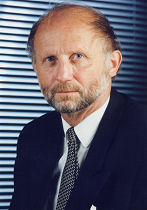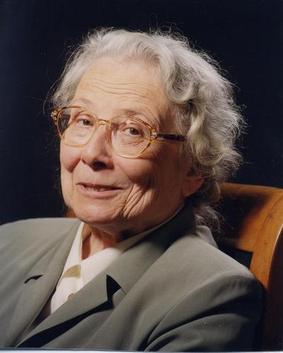
Richard Johann Kuhn was an Austrian-German biochemist who was awarded the Nobel Prize in Chemistry in 1938 "for his work on carotenoids and vitamins".

Achim Müller is a German chemist. He is Professor Emeritus at the Faculty of Chemistry, University of Bielefeld.
Marion Frederick Hawthorne was an inorganic chemist who made contributions to the chemistry of boron hydrides, especially their clusters.

Georg Bredig was a German physical chemist. Bredig was a faculty member at the University of Leipzig (1895-1901) and professor of chemistry at Heidelberg (1901–1910); Technische Hochschule, Zurich (1910); and Technische Hochschule, Karlsruhe (1911–1933).

Stefan Walter Hell HonFRMS is a Romanian-German physicist and one of the directors of the Max Planck Institute for Biophysical Chemistry in Göttingen, Germany. He received the Nobel Prize in Chemistry in 2014 "for the development of super-resolved fluorescence microscopy", together with Eric Betzig and William Moerner.

François Diederich was a Luxembourgian chemist specializing in organic chemistry.
The Alfred-Stock Memorial Prize or Alfred-Stock-Gedächtnispreis is an award for "an outstanding independent scientific experimental investigation in the field of inorganic chemistry." It is awarded biennially by the German Chemical Society. The award, consisting of a gold medal and money, was created in 1950 in recognition of the pioneering achievements in inorganic chemistry by the German chemist Alfred Stock. In 2022, the GDCh board decided to change the name of the previous Alfred Stock Memorial Prize. The new name is Marianne Baudler Prize.

The Liebig Medal was established by the Association of German Chemists in 1903 to celebrate the centenary of Justus von Liebig. Since 1946 it has been awarded by the Society of German Chemists.

Wilhelm Biltz was a German chemist and scientific editor.
Bernt Krebs is a German scientist. He is conducting research at the Faculty of Chemistry, University of Münster.
Frank Neese is a German theoretical chemist at the Max Planck Institute for Coal Research. He is the author of more than 440 scientific articles in journals of Chemistry, Biochemistry and Physics. His work focuses on the theory of magnetic spectroscopies and their experimental and theoretical application, local pair natural orbital correlation theories, spectroscopy oriented configuration interaction, electronic and geometric structure and reactivity of transition metal complexes and metalloenzymes. He is lead author of the ORCA quantum chemistry computer program. His methods have been applied to a range of problems in coordination chemistry, homogeneous catalysis, and bioinorganic chemistry.

Margot Becke-Goehring was a Professor of Inorganic Chemistry at the University of Heidelberg and she was the first female rector of a university in West Germany - the Heidelberg University. She was also the director of the Gmelin Institute of Inorganic Chemistry of the Max Planck Society that edited the Gmelins Handbuch der anorganischen Chemie. She studied Chemistry in Halle (Saale) and Munich, and she finished her doctorate and habilitation at the University of Halle. For her research on the chemistry of main-group elements, she was awarded Alfred Stock Memorial Prize. One of her most notable contributions to inorganic chemistry was her work on the synthesis and structure of poly(sulfur nitride), which was later discovered to be the first non-metallic superconductor. For her success in editing the Gmelins Handbuch der anorganischen Chemie, she received the Gmelin-Beilstein memorial coin.
Peter Richard Schreiner is a German chemist who is a professor at Justus Liebig University Giessen. As of 2022, his h-index is 73.
Wilhelm Karl Klemm was an inorganic and physical chemist. Klemm did extensive work on intermetallic compounds, rare earth metals, transition elements and compounds involving oxygen and fluorine. He and Heinrich Bommer were the first to isolate elemental erbium (1934) and ytterbium (1936). Klemm refined Eduard Zintl's ideas about the structure of intermetallic compounds and their connections to develop the Zintl-Klemm concept.
Marianne Baudler was a German chemist. She is known for her research on phosphorus.
Katharina Kohse-Höinghaus is a German chemist.
Stefanie Dehnen is a German chemist. She is the executive director of the Institute of Nanotechnology at the Karlsruhe Institute of Technology. From 2006 to 2022, she was a full professor for inorganic chemistry at the University of Marburg. She has received numerous awards for her research in inorganic chemistry. In 2024 and 2025, she will be the president of the German Chemical Society.
Arndt Simon is a German inorganic chemist. He was a director at the Max Planck Institute for Solid State Research in Stuttgart.
Hans Georg von Schnering was a German chemist and professor of inorganic chemistry at the University of Münster, honorary professor at the University of Stuttgart and director at the Max Planck Institute for Solid State Research.
Stefan Grimme, is a German physical chemist; he completed a Ph.D. thesis on photochemistry at Technical University of Braunschweig in 1991; he is a professor at the Universität Bonn since 2011 who is active in the field of computational chemistry; he was elected a member of the Academy of Sciences Leopoldina in 2018.








